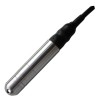What is the method of shunt calibration in relation to an indicator connected to a pressure transducer?
Shunt calibration is a convenient way of calibrating a wheatstone bridge strain gauge circuit which is a common technology used in pressure transducers. It’s not a complete calibration, since no actual pressure is applied when conducting a shunt calibration, but it does reduce the errors associated with the electrical characteristics of the strain gauges and the connected electrical components.
Basically a shunt resistor is added in parallel to one of the strain gauges to simulate what would happen if a real load was measured by the pressure transducer. Since the resistance is known, the resulting output in millivolts can be compared to what should be expected when the equivalent real pressure is applied. Then the difference in output signal can be compensated within the monitoring instrumentation.
Featured strain gauge related products
 IMSL IP68 Stainless Steel 316L Hydrostatic Pressure Sensor - Water resistant pressure sensor for measuring hydrostatic pressures in the range of 0-0.5 mWC up to 0-100 mWC.
IMSL IP68 Stainless Steel 316L Hydrostatic Pressure Sensor - Water resistant pressure sensor for measuring hydrostatic pressures in the range of 0-0.5 mWC up to 0-100 mWC. TPF Flush Diaphragm Strain Gauge Pressure Sensor - Flush diaphragm piezo-resistive pressure sensor for food processing and plastic injection moulding applications with a millivolt output signal in pressure ranges from 10 up to 1000 barg.
TPF Flush Diaphragm Strain Gauge Pressure Sensor - Flush diaphragm piezo-resistive pressure sensor for food processing and plastic injection moulding applications with a millivolt output signal in pressure ranges from 10 up to 1000 barg.
Related Help Guides
Related Technical Terms
- BFSG – Bonded Foil Strain Gauge
- mV/V – Millivolts per Volt Output Signal
- Piezoresistive Strain Gauges
- Span Sensitivity
- Strain Gauge
- Thin Film
- Wheatstone Bridge Strain Gauge
